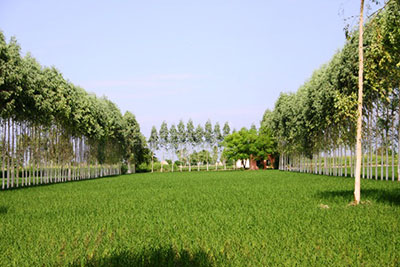It will not be wrong to say that efforts made by the Haryana Forest Department for the progress of agro-forestry are amongst the best in the country. Furthermore, the farmers of Haryana state have adopted this income generation system as an inseparable part of their farmer’s practices. Haryana state has both wet and arid regions and accordingly both rain-fed and irrigated agriculture is practiced by the farmers. Consequently, many suitable agroforestry models have been developed by the forest department, while some others have been evolved by farmers through practical exposure.
Agro-forestry Models
The major objective of agro-forestry is to optimize production and economic returns per unit area while respecting the principle of sustainable development. In order to attain this objective, certain agroforestry models have been evolved and standardized, combining optimum land use system with tree-agriculture-livestock production system to give maximum economic returns, simultaneously or sequentially. However, the models have to be designed in such a manner so as to make them technologically feasible, ecologically sustainable, economically viable, and socially acceptable. In Haryana state, poplar and eucalyptus have been two popular species for agroforestry.
Poplar based Agro-forestry Models
 The poplars having straight bole, being leafless during winter month, combining well with the agriculture crops, giving good economic returns in short-rotation i.e. 5-7 years with easy availability of bank loans, have become the most popular tree species for planting under Agroforestry systems after 1980 in Haryana, Punjab, Uttar Pradesh, Himachal Pradesh, and Arunachal Pradesh states. Farmers are cultivating agricultural crops throughout the harvesting period and consider poplar trees as assured wealth of their future needs. The spacing for poplar plantation is generally kept at 5m x 4m or 5m x 5m, which allows tractor ploughing and other cultivation operations without any difficulty. The agriculture crops which are generally grown as an intercrop with poplar plantation, are sugarcane, wheat, potato, gram, mustard, pea, soybean, lentil, sorghum, maize, zinger, turmeric, and vegetable crops like tomato, chilies, radish, etc. Considering the fast rate of growth, ease of establishment, easy marketing, and multifarious uses, poplars have grown under various systems viz. Agri-silvicultural, Agri-silvi-horticultural etc. Poplar planting also helps in protecting agricultural crops from the scorching sun, desiccating effect of wind, and also control soil erosion. The fertile soil and high water table have been found quite favorable for raising poplar plantations.
The poplars having straight bole, being leafless during winter month, combining well with the agriculture crops, giving good economic returns in short-rotation i.e. 5-7 years with easy availability of bank loans, have become the most popular tree species for planting under Agroforestry systems after 1980 in Haryana, Punjab, Uttar Pradesh, Himachal Pradesh, and Arunachal Pradesh states. Farmers are cultivating agricultural crops throughout the harvesting period and consider poplar trees as assured wealth of their future needs. The spacing for poplar plantation is generally kept at 5m x 4m or 5m x 5m, which allows tractor ploughing and other cultivation operations without any difficulty. The agriculture crops which are generally grown as an intercrop with poplar plantation, are sugarcane, wheat, potato, gram, mustard, pea, soybean, lentil, sorghum, maize, zinger, turmeric, and vegetable crops like tomato, chilies, radish, etc. Considering the fast rate of growth, ease of establishment, easy marketing, and multifarious uses, poplars have grown under various systems viz. Agri-silvicultural, Agri-silvi-horticultural etc. Poplar planting also helps in protecting agricultural crops from the scorching sun, desiccating effect of wind, and also control soil erosion. The fertile soil and high water table have been found quite favorable for raising poplar plantations.
Studies on the economics of poplar plantations grown by Forest Department on govt. land and by cultivators on their own farms were conducted at Forest Research Institute Dehradun (Mathur and Sharma 1983). The annual returns were discounted at 12, 15, 20, and 25 percent. The net present value (NPV) per hectare in the case of poplar plantation with and without agriculture in the forest land and on farm lands with agriculture at 8, 10 and 12 year rotation was calculated. The NPV and benefit cost ratio (B/C) was found maximum at 12 percent discount rate with 8 years rotation. It was concluded cultivation of agriculture crops with poplar at 8 years rotation ensures higher economic returns.

